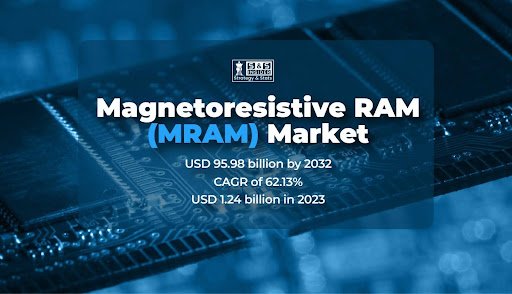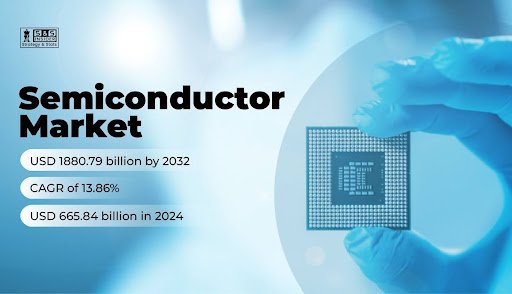The Magneto Resistive RAM (MRAM) Market is rapidly gaining attention in the semiconductor and memory storage industry due to its high speed, non-volatility, and low power consumption. MRAM technology is poised to revolutionize the way data is stored and accessed, providing significant advantages over traditional memory solutions like DRAM and SRAM. The increasing demand for faster, energy-efficient, and durable memory solutions in consumer electronics, automotive, aerospace, and industrial applications is driving this market’s growth. Moreover, the expansion of IoT devices, AI applications, and cloud computing is further accelerating the adoption of MRAM globally.
Market Size and Growth of Magneto Resistive RAM (MRAM)
As per the SNS Insider, The Magneto Resistive RAM (MRAM) Market Size was valued at USD 1.24 billion in 2023 and is expected to reach USD 95.98 billion by 2032, growing at a staggering CAGR of 62.13% during the forecast period 2024-2032. This explosive growth can be attributed to the continuous technological advancements in MRAM manufacturing, the rising demand for non-volatile memory solutions, and the adoption of MRAM in next-generation electronics. Companies are increasingly investing in research and development to enhance memory density, speed, and energy efficiency, which is projected to further boost market expansion.
Key Drivers of the Magneto Resistive RAM (MRAM) Market
Several factors are fueling the growth of the Magneto Resistive RAM (MRAM) Market. Firstly, the shift towards energy-efficient memory solutions in electronics and automotive applications is significant. MRAM consumes less power compared to traditional memory technologies, making it an ideal choice for battery-powered devices and edge computing applications. Secondly, its non-volatility ensures that data is retained even when the power is switched off, which is crucial for mission-critical applications in aerospace, defense, and industrial automation. Lastly, MRAM’s fast read/write capabilities make it suitable for AI, machine learning, and high-speed computing applications, further driving market demand.
Challenges Facing the Magneto Resistive RAM (MRAM) Market
Despite its advantages, the Magneto Resistive RAM (MRAM) Market faces certain challenges. The high initial production cost and complex manufacturing process remain barriers for widespread adoption. Additionally, integrating MRAM into existing systems requires significant technological adjustments, which may slow down its implementation in certain regions. Furthermore, competition from other emerging memory technologies such as ReRAM, PCM, and 3D NAND can pose a threat to MRAM’s market share in specific applications. Companies must continue to innovate and reduce production costs to overcome these challenges.
Opportunities in the Magneto Resistive RAM (MRAM) Market
The Magneto Resistive RAM (MRAM) Market offers several lucrative opportunities for growth. With the increasing adoption of IoT devices and smart electronics, the demand for fast, energy-efficient, and durable memory solutions is expected to surge. Additionally, the automotive sector presents a significant growth avenue, particularly with the rise of electric vehicles (EVs) and autonomous driving systems that require reliable and low-power memory solutions. Cloud computing and AI-driven applications are also expected to fuel MRAM demand, enabling faster data processing and improved system performance.
Regional Insights of the Magneto Resistive RAM (MRAM) Market
Regionally, North America leads the Magneto Resistive RAM (MRAM) Market due to the presence of major semiconductor companies, robust R&D activities, and high adoption of advanced technologies. Europe is witnessing steady growth, supported by government initiatives in smart electronics and industrial automation. The Asia-Pacific region is projected to be the fastest-growing market, driven by rapid industrialization, expansion of consumer electronics, and strong investments in semiconductor manufacturing in countries like China, Japan, and South Korea.
Future Outlook of the Magneto Resistive RAM (MRAM) Market
The future of the Magneto Resistive RAM (MRAM) Market looks extremely promising, with continuous technological innovations and rising adoption across multiple end-user industries. As memory-intensive applications grow, MRAM’s unique combination of speed, non-volatility, and low power consumption is expected to make it a mainstream memory solution. The market is poised for further expansion, supported by strategic collaborations, partnerships, and increasing production capacities by leading players globally.
FAQs About Magneto Resistive RAM (MRAM) Market
Q1: What is the expected CAGR of the Magneto Resistive RAM (MRAM) Market?
A: The Magneto Resistive RAM (MRAM) Market is expected to grow at a CAGR of 62.13% from 2024 to 2032, reflecting rapid adoption across multiple industries and technological advancements.
Q2: What is the forecasted market size of the Magneto Resistive RAM (MRAM) Market by 2032?
A: The market is projected to reach USD 95.98 billion by 2032, up from USD 1.24 billion in 2023, driven by increasing demand for non-volatile, energy-efficient, and high-speed memory solutions.
Q3: Which regions are expected to dominate the Magneto Resistive RAM (MRAM) Market?
A: North America currently leads the market due to advanced semiconductor infrastructure and strong R&D. Asia-Pacific is expected to witness the fastest growth owing to rapid industrialization, expansion of consumer electronics, and heavy investments in semiconductor manufacturing.










